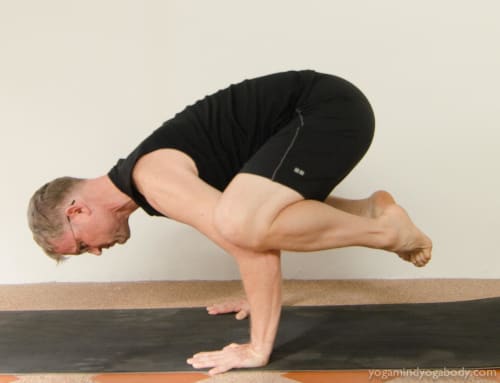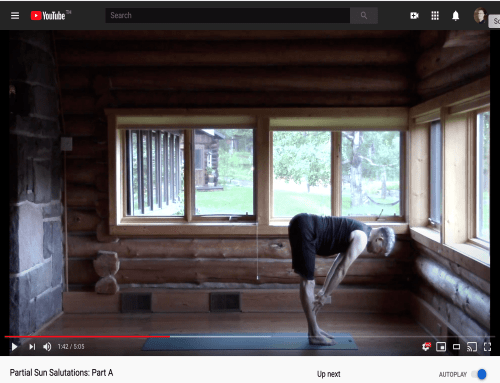Keeping your knees safe is important but challenging, because the knee joints, despite their size, are rather fragile joints. One main reason is that there is no overlap of the two bones meeting to create the joint. That means the knee joints can move into problematic alignment with relative ease. Crescents of cartilage (the menisci) create a shallow joint socket to keep the two halves of the joint better aligned. However, because the menisci are cartilaginous soft tissue, it is relatively easy to damage them through poor knee alignment. Moving your knees with awareness is important to protect these delicate joints that bear tremendous weight. Having focused on increasing hip awareness and range of motion for the past couple of weeks, this week we will focus on bringing more awareness to our knees.
Tight Hips Can Contribute to Knee Problems
One reason why knee placement is challenging is tightness in the hips. Such hip tightness can result in unintentional movement in the knees to make up for the lack of hip movement. The most dramatic pose where this problem is evident is lotus pose. The hip joint is a stronger and better-protected joint than the knee. Thus in poses where hip flexibility is insufficient, it is surprisingly easy to force the knees to provide the desired range of motion that the stronger hip joints are denying. This causes the knees to move in ways in which they were not designed to move. And that in turn can damage the knee joints. The most common injury resulting from poor knee alignment is a meniscus tear. This is doubly unfortunate, because the menisci help keep the knees in alignment.
Learn to Listen to Your Knees to Keep Your Knees Safe
The good news is that when the knee moves in ways it isn’t designed to, it tends to complain appropriately. In other words, pain sensations in the knee are generally an accurate indication of actual problems developing, which is not true in all parts of the body. (For example, partially tearing an upper hamstring tendon attachment does not usually trigger pain sensations at the time that the damage is occurring. This is one major reason why that is such a common yoga injury, and why it is so easy to re-injure).
Thus never suffer through knee pain quietly, hoping it will go away eventually. It won’t, and while your knees are in pain, you are not only risking knee injury. You are also not getting an effective hip opening, as you are concentrating the force in the knees instead of the hips. If you experience knee pain in a yoga pose, find a way to make it go away, even if that means not doing that particular pose. You will probably find that protecting the knee actually creates a more effective hip stretch, as you are no longer transferring the movement from the hips to the knee joints.
Keep Your Knees Safe
In order to protect the knees we will focus this week on knee alignment and on opening the hips to reduce the strain on the knees. We will also focus on balanced engagement of the leg muscles. Evenly engaging and strengthening all the leg muscles keeps your knee joints aligned and your knees healthy long-term. When the knees are flexed, we generally create that engagement through a neutral ankle and flexed toes. When the knee joints are extended, we create that engagement by hugging our leg muscles around our bones.
Try it now
Lying on the floor, bend the left knee 90 degrees, planting your left foot on the floor. Then place the base of the right shin across the left thigh near the knee.
Did you really do that, or did you instead place the outside edge of the right foot on the left thigh? If so, why? Because you unconsciously know that you can rotate your right knee farther away that way. Unfortunately, this can put asymmetrical stress on your right knee which can cause real damage. On top of that, it also makes the intended hip stretch less effective. Essentially you have found a way to avoid the hip stretch by collapsing your ankle joint and compromising your knee joint.
Instead slide the right foot all the way across the left thigh and flex your right toes towards the right knee. This evenly engages muscles on the outer and inner leg to keep the right knee symmetrically aligned and safe. Then, with each exhale, rotate the right knee away from the chest. With each inhale, find softness and spaciousness in the pose while checking the right ankle alignment. Note that your knee is now closer to your chest and you might now feel less accomplished. However, also note that you are now probably experiencing a stronger hip stretch. If you do, that means this hip stretching exercise has not only gotten safer, but also more effective. After 10 breaths or so, repeat on the left side.







Hello, A lot of people are recommended knee-surgery. Are there any Yoga asanas which can help people avoid knee-surgery?
My answer is a qualified yes. Of course it depends on the severity of your knee issues, but strengthening the muscles that cross the knee, maintaining good knee alignment, and not putting too much stress on your knees can go a long way towards delaying or avoiding knee surgery. To strengthen the muscles that cross the knee, try one-legged balancing poses like Tree. In addition, try a wide-legged stance while moving your upper body in 6 directions: backbend, forward bend, twist to one side with backbend and then forward bend, repeat with a twist to the other side. One move per breath, while hugging the leg muscles around the knees and the leg bones throughout. I’d also highly recommend this article by one of my yoga teachers, Doug Keller: http://www.doyoga.com/articles_all/7_july_07_knees.pdf
Best of luck!
By the way, the research indicates overwhelmingly that knee surgery doesn’t work any better than doing nothing. See the bottom of this article for a summary of the research: https://www.drmirkin.com/fitness/running-may-help-to-protect-your-knees.html
Thanks for the advice. I will also go through the article. Thanks again.